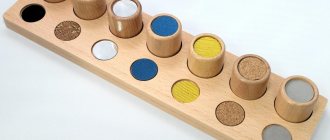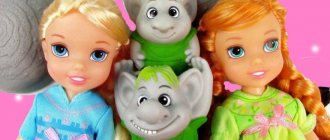Summary of GCD in the senior group. Such a different theater
Author: Guzhieva Elizaveta Aleksandrovna, teacher of the preschool educational institution “Kindergarten No. 64”, Republic of Karelia, Petrozavodsk
Description of the material: I offer you a summary of direct educational activities for children of the preparatory group (6-7 years old) on the topic “Such a different theater.” This summary will be useful to the teacher of the preparatory group. This summary is aimed at understanding the objective and social world, as well as at mastering safe behavior. The summary uses some techniques of socio-game technology. Summary of direct educational activities for children 6-7 years old Topic: Such a different theater Section: Cognitive and research activities. Understanding the objective and social world, mastering safe behavior. Thematic week: Theater living room Goal: Expand children's understanding of the theater Objectives: 1. Teach children to express themselves creatively. 2. To introduce the varieties and features of theaters 3. To improve verbal communication skills. 4. Improve the ability to express your opinion. 5. Strengthen the ability to work in mini-groups and the ability to negotiate. Materials: Invitation letter Illustration of a theater wardrobe Illustrations of a drama theatre, puppet theatre, opera and ballet theater Cut-out pictures Illustrations with attributes Audio recording Facial contours for depicting emotions Hats of fairy-tale characters for the game “Guess whose hat it is”
Stages of joint activity:
Stage 1 Immersion Children stand in a circle. Educator: Good morning! - the sun and the birds. Good morning! - smiling faces. Good afternoon, good hour! I'm very glad to see you! Educator: Guys, today we received a letter of invitation to the theater: “Friends are glad to welcome you! My name is Pierrot, my life is in the theater. And it’s not in vain that I’m writing a letter to you today. I want to open my wonderful world for you. Invite me to the magical world of theater” - Do you know what theater is? (children's answers) - Are you interested in visiting the theater? Children: Yes Educator: To visit the theater we need to be in a good mood. Let's raise it together, and for this we clap our hands together, have fun! (clap their hands to the clap) Feet, feet began to pound louder and stronger. Our hands began to spin and immediately dropped. They circled, circled and stopped. The mood was lifted and we got to the theater. Stage 2 Main Educator: - How do you understand the expression “The theater begins with a hanger” (children’s answers) - That’s right, the theater is a special place where there is a warm, pleasant atmosphere, people dress smartly and one of the rules of visiting the theater is “No outerwear enter!" — Theaters are different, but this rule is usually observed in all types of theater. With the help of cut-out pictures, we will find out what types of theaters there are. These pictures will also help you divide into teams. (children themselves choose the first part of a cut-out picture with images of a drama theater, puppet theater, opera and ballet theater, then the children form teams). Educator: - Each team needs to be divided into 1st, 2nd and 3rd. — Team member with number 2, let him come up and take the same picture as the cut one, only the whole one, in order to make it easier to look at. - Teams will try to tell what is shown in the picture (one team tells, the other two complement or correct), (the teacher clarifies the name of each theater). Educator: - Guys, what do you need to show a performance? (children's answers) - Since theaters are different, they need different attributes (objects) for the performance, and we will try to figure out which ones and for which theater. To do this, let the guys with number 1 come up. (children take the illustrations) - Children, from all the pictures you need to choose only those that are suitable for your theater, and explain your choice (children choose the necessary pictures) - Do you know who works in theater? (children's answers) - Who shows all these performances? (children's answers) - Guys, I suggest you turn into actors. Do you agree? (yes) - I will be the director and give you ideas for your performance. (teacher's story about the profession of a director) - Let the children with number 3 come up to me and take cards with tasks? The teacher reminds that in a drama theater the actors speak and sing; in ballet they show the body (dance); Dolls play in the puppet theater. When one team shows, the other two act as spectators, but with tasks (team 1 shows, team 2 praises, team 3 criticizes). — After each performance, what do the audience do? (applaud) - So you and I attended performances in different theaters. The performances are wonderful and exciting. You are simply great! - Now the performance is over, but where do we go next? (children's answers) - Of course, to the wardrobe. — Are you interested to know who else was in the theater? (children’s answers) Game “Guess Whose Hat”
The teacher invites the children to find something belonging to each of the theater visitors, for example, to choose a hat for each character: Little Red Riding Hood, Santa Claus, Puss in Boots, postman Pechkin.
Stage 3 Final - What new did you learn about the theater - What types of theaters did you remember? — We came to the theater in a good mood, and now, after visiting the theater, what’s your mood? (Draw your mood (emotions) on the contour of your face)
We recommend watching:
Summary of educational activities in the senior group “Northern Adventures” Summary of a conversation with children of senior preschool age Summary of educational activities in speech therapy for the senior group Methodological development of a summary of an excursion for children of senior preschool age
Similar articles:
Summary of a mathematics lesson in the senior group of kindergarten. Geometric figures



